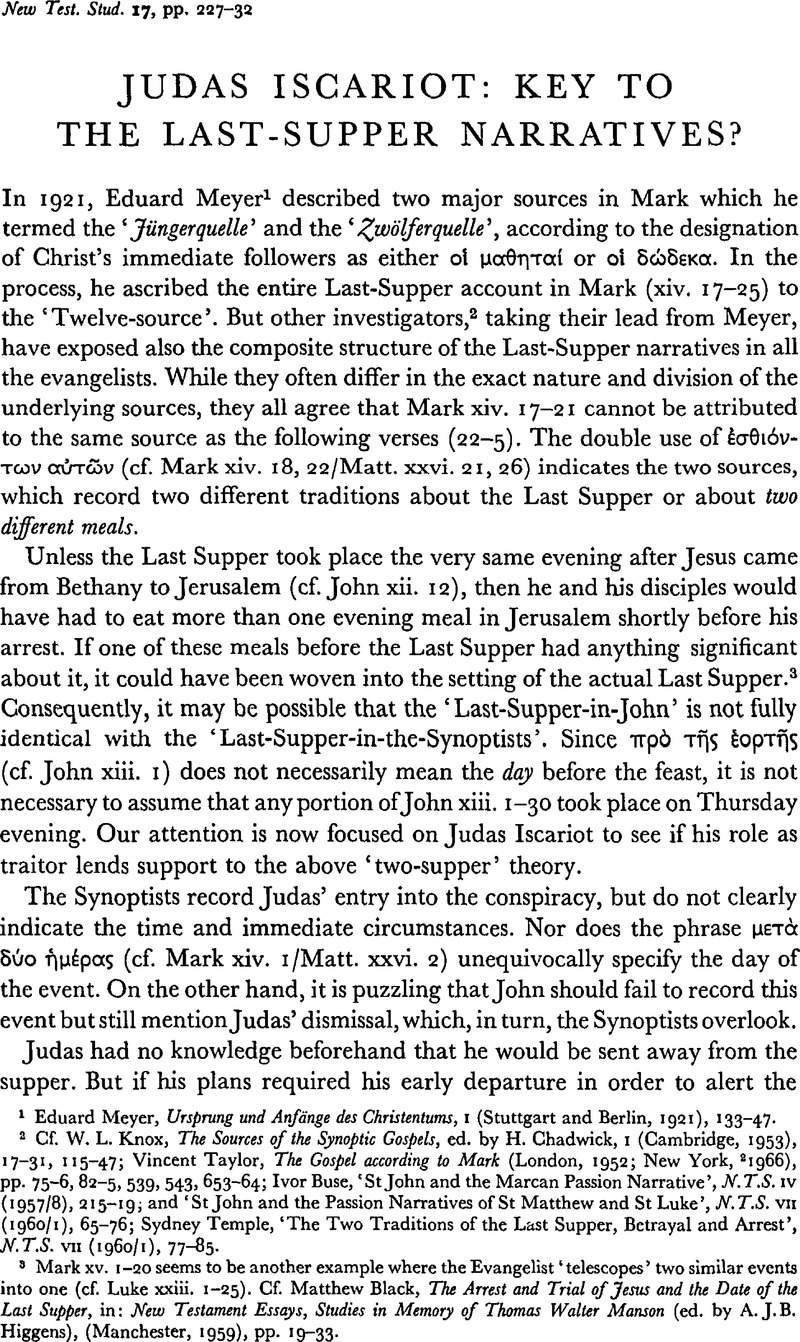Article contents
Judas Iscariot: Key to the Last-Supper Narratives?
Published online by Cambridge University Press: 05 February 2009
Abstract

- Type
- Short Studies
- Information
- Copyright
- Copyright © Cambridge University Press 1971
References
page 227 note 1 Meyer, Eduard, Ursprung und Anfänge des Christentums, I (Stuttgart and Berlin, 1921),133–47.Google Scholar
page 227 note 2 Cf. Knox, W. L., The Sources of the Synoptic Gospels, ed. by Chadwick, H., I (Cambridge, 1953), 17–31, 115–47;Google ScholarTaylor, Vincent, The Gospel according to Mark (London 1952; New York2,1966)Google Scholar, pp. 75–6, 82–5, 539, 543, 653–64; Buse, Ivor, ‘St John and the Marcan Passion Narrative’, N.T.S. iv (1957/8), 215–19;Google Scholarand ‘St John and the Passion Narratives of St Matthew and St Luke’, N.T.S. VII (1960/1), 65–76;Google ScholarSydney Temple, 'The Two Traditions of the Last Supper, Betrayal and Arrest’, NTS. vii (1960/1), 77–85.Google Scholar
page 227 note 3 Mark xv. 1–20 seems to be another example where the Evangelist ‘telescopes’ two similar events into one (cf. Luke xxiii. 1–25). Cf. Black, Matthew, The Arrest and Trial of Jesus and the Date of the Last Supper, in: New Testament Essays, Studies in Memory of Thomas Walter Manson (ed. by Higgens, A. J. B.), (Manchester, 1959), PP. 19–33.Google Scholar
page 228 note 1 Cf. Ruckstuhl, E.,Judaskommunion, in: Bibel-Lexikon (ed. byHaag, H.), (Einsiedeln, 1951) cols. 867–8.Google Scholar
page 228 note 2 Cf. βάλλω, in: Liddell, and Scott, , A Greek-English Lexicon. The possible uses of the expression in question can best be seen in a number of examples: I. το⋯ς ⋯μούς λόγους θυμῷ βάλ', ώς άν τέρματ' έκμάθῃς όδο⋯. ‘Take my words to heart, so that you may learn the way-signs’ (Aeschylus,Prometheus Vinctus,705–6). 2.Google Scholar μή ν⋯ν ἔτ' αύτ⋯ν μηδ⋯ν⋯ς θυμ⋯ν βάλῇδ. ‘Don't let any of these things into (your) heart’ (Sophocles, Oedipus Tyrannus, 975). 3. αύτάρ ν⋯ν τοι ⋯γώ μαντεύσομαι, ώδ ⋯νι θυμῷ άθάνατοι βύλλουσι και ώδ τελέεσθαι ⋯ιω, ο⋯ντιδ ⋯ών οὔτ' οιων⋯ν σάϕα εìδώδ. ‘Though I'm no sort of prophet, nor do I know how to interpret the flights of birds, I shall now prophesy how the gods lay it in (my?) heart and how it will probably turn out’ (Homer, Odyssey, 1, 200–2). However, the following may also be possible: ‘Though I'm no …, I shall now prophesy how the gods are planning it within (their) heart and how …’. 4. παλλ⋯ δ' ⋯ν καρδιαις άνδρ⋯ν ἔβαλον ‘ωραι πολυάνθμοι άρ⋯αια σοϕισμαθ’. ‘The flower-rich seasons have often put the inventions of old in(to) the hearts of men’ (Pindarus, Olympian, 13, 16–17).
page 229 note 1 Cf. Foerster, , Σαταν⋯ς, in: Theologisches Wörterbuch zum Neuen Testament, vii, 163.Google Scholar
page 229 note 2 Loc. cit.Google Scholar
page 231 note 1 Cf. de Nisibe, Éphrem, Commentaire de L'Évangile Concordant ou Diatessaron (translated and annotated by Leloir, Louis), in: Sources Chréliennes, cxxi (Paris, 1966), 332–3.Google Scholar
- 2
- Cited by


